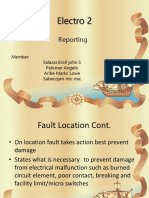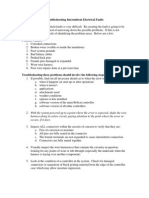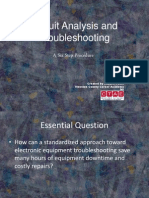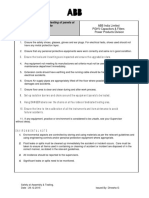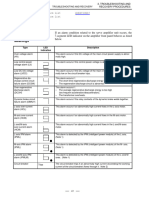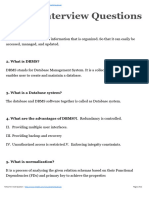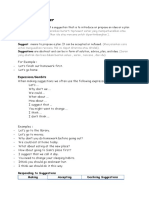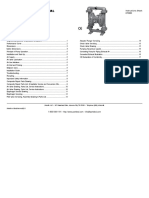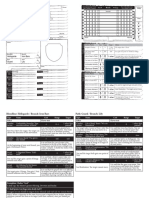0% found this document useful (0 votes)
28 views4 pagesTroubleshooting Flowchart Without PLC
This document is a troubleshooting flowchart for diagnosing electrical control system failures in machines without a PLC. It outlines a step-by-step process starting from checking the main power supply to identifying localized faults and environmental factors affecting the system. The flowchart concludes with options for consulting manuals or using advanced diagnostics if issues persist.
Uploaded by
Ron SCopyright
© Public Domain
We take content rights seriously. If you suspect this is your content, claim it here.
Available Formats
Download as PDF, TXT or read online on Scribd
0% found this document useful (0 votes)
28 views4 pagesTroubleshooting Flowchart Without PLC
This document is a troubleshooting flowchart for diagnosing electrical control system failures in machines without a PLC. It outlines a step-by-step process starting from checking the main power supply to identifying localized faults and environmental factors affecting the system. The flowchart concludes with options for consulting manuals or using advanced diagnostics if issues persist.
Uploaded by
Ron SCopyright
© Public Domain
We take content rights seriously. If you suspect this is your content, claim it here.
Available Formats
Download as PDF, TXT or read online on Scribd
/ 4
Troubleshooting Flowchart: System Without PLC
This flowchart guides you through diagnosing electrical control system failures in machines that
do not use a Programmable Logic Controller (PLC) for their primary control logic. It focuses on
direct wiring, relays, contactors, and hardwired safety circuits.
START: Machine Not Operating
1. Check Main Power Supply
○ Is there power at the main disconnect (incoming lines)?
■ NO:
■ Check building main breaker.
■ Verify utility power supply.
■ Inspect supply receptacle/plug for damage or loose connections.
■ YES: Proceed to Step 2.
2. Check Machine Main Fuses / Breaker
○ Are main fuses blown or main machine breaker tripped?
■ YES:
■ Replace fuses / Reset breaker.
■ Investigate Cause: Look for obvious overloads, short circuits, or
ground faults in the main power distribution.
■ NO: Proceed to Step 3.
3. Check for Lost Phase (for 3-Phase Systems)
○ Measure voltage across all three phases (L1-L2, L2-L3, L3-L1) at the main
disconnect or machine input terminals.
■ YES (one or more phases missing/low):
■ Check incoming supply wiring for open circuits.
■ Inspect main fuses for a single blown fuse.
■ Contact utility if issue is upstream of your main disconnect.
■ NO (all phases present and correct voltage): Proceed to Step 4.
4. Determine Scope of Failure
○ Is the entire machine dead (no lights, no control power, no hum)?
■ YES: Proceed to Step 5 (Control Power Circuit).
■ NO (Partial failure, e.g., lights on, but specific function not working):
Proceed to Step 9 (Localized Fault).
5. Control Power Circuit (If Entire Machine is Dead)
○ Check control power input fuses/breaker (e.g., primary side of control
transformer).
■ NO (blown/tripped):
■ Replace fuse / Reset breaker.
■ Investigate Cause: Look for shorts in the control circuit wiring.
■ YES (OK): Proceed.
○ Check control transformer output voltage.
■ NO (no output voltage): Replace control transformer.
■ YES (voltage present): Proceed to Step 6.
○ Check control power output fuses (e.g., secondary side of control
transformer or power distribution block).
■ NO (blown):
■ Replace fuse.
■ Investigate Cause: Look for shorts in the control circuit after the
transformer.
■ YES (OK): Proceed to Step 6.
6. Safety Circuit Loop (E-Stops, Safety Switches, Interlocks)
○ Are any E-stops engaged, or safety guards/interlocks open?
■ YES: Reset E-stops, close guards, ensure interlocks are engaged.
■ NO: Proceed.
○ Test entire E-stop/Safety Loop for continuity (typically a series circuit that
de-energizes a control relay).
■ OPEN CIRCUIT:
■ Troubleshoot individual E-stop/safety switch/interlock: Check
for stuck buttons, broken wires, misaligned sensors, or tripped
safety relays.
■ Verify each device in the loop is closed when it should be.
■ CLOSED CIRCUIT: Proceed to Step 7.
7. Operator Input / Control Devices
○ Is the START button, selector switch, or other primary control device
functioning (e.g., does it have continuity when pressed/selected)?
■ NO: Replace/repair the faulty control device.
■ YES: Proceed to Step 8.
○ Is there any operator feedback (e.g., fault message on a display, indicator
light, alarm)?
■ YES: Consult machine manual for specific code/message interpretation.
■ NO: Proceed to Step 8.
8. Control Relays / Contactors
○ Trace the control circuit from the operator input to the main contactor or
motor starter coil.
○ Is the coil of the main contactor/starter energizing when it should?
■ NO:
■ Check for voltage at the coil.
■ If no voltage, trace back through any intermediate control relays
(e.g., auxiliary relays, timer relays, limit switch contacts) in the
circuit.
■ Test continuity of all normally open (NO) and normally closed (NC)
contacts in the control path.
■ Troubleshoot/replace faulty relays or wiring.
■ YES (coil energizes, but load not running): Proceed to Step 9
(Localized Fault, focusing on the load circuit).
9. Localized Fault (Specific Function/Component Not Working)
○ Identify the specific component or circuit involved (e.g., a single motor, a
solenoid valve, a heating element).
○ Check local fuses/breakers for that specific circuit.
■ NO (blown/tripped):
■ Replace fuse / Reset breaker.
■ Investigate Cause: Look for overload or short in that specific load
circuit.
■ YES (OK): Proceed.
○ Check for voltage at the component's terminals when it should be
operating.
■ NO:
■ Trace back wiring from the component to its power source (e.g.,
main contactor, auxiliary contactor, direct power feed).
■ Check associated relays/contactors/switches that control this
specific component.
■ Verify continuity of wiring.
■ YES: Proceed to Step 10.
10.Load / Motor Protection (Overload Relays)
○ Is the overload relay (for motors or other high-current loads) tripped?
■ YES:
■ Reset the overload.
■ Investigate Cause:
■ Mechanical binding/excessive load on the motor.
■ Motor fault (e.g., winding short, bearing failure).
■ Incorrect overload setting.
■ Phase imbalance.
■ Allow time for motor to cool if thermal overload.
■ NO: Proceed to Step 11.
11.Check Component Itself
○ For Motors:
■ Measure winding resistance: Look for open or shorted windings.
■ Check bearings: Listen for noise, feel for excessive heat/vibration.
■ Verify mechanical connection: Is the shaft free to turn?
○ For Solenoids/Coils:
■ Measure coil resistance: Look for open coil (infinite resistance) or
shorted coil (very low resistance).
■ Check for plunger movement: Is it stuck?
○ For Heating Elements:
■ Measure resistance: Look for open circuit.
○ Is the component faulty based on tests/inspection?
■ YES: Replace the component.
■ NO: Proceed to Step 12.
12.General Checks & Environmental Factors
○ Physical Damage:
■ Inspect all wiring, terminals, components, and enclosures for visible
damage (chafing, cuts, burns, cracks).
■ YES: Repair or replace damaged parts.
■ NO: Proceed.
○ Water Damage / Contamination:
■ Look for evidence of moisture, corrosion, dust, or foreign material
inside enclosures or on components.
■ YES: Clean, dry thoroughly, repair/replace affected parts. Ensure proper
sealing/environmental protection.
■ NO: Proceed.
○ Loose Connections:
■ Physically check and tighten all terminal screws, wire nuts, and
cable connections. Loose connections can cause intermittent faults,
overheating, and voltage drops.
■ YES: Tighten/repair.
■ NO: Proceed.
○ Heat / Smell:
■ Feel components and wiring for excessive heat. Smell for burning
insulation.
■ YES: Identify the source of overheating, repair or replace the affected
component/wiring.
■ NO: Proceed.
13.Consult Manual / Advanced Diagnostics
○ If the issue persists, consult the machine-specific manual for detailed
schematics, sequence of operations, and advanced troubleshooting
guides.
○ Consider using specialized test equipment (e.g., megohmmeter for insulation
testing, thermal camera for hot spots, oscilloscope for signal integrity).
○ Consider intermittent fault: Monitor the system with a data logger or observe
during operation for transient conditions.

